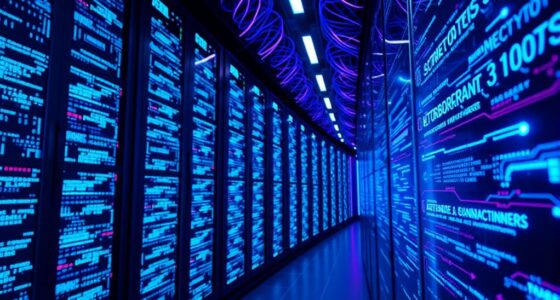As a cybersecurity expert, I have seen how threats in the digital world are constantly changing. Artificial intelligence security plays a crucial role in defending against cyber attacks by staying one step ahead and being prepared to counter any incoming threats.
With its advanced algorithms and machine learning capabilities, AI has revolutionized threat detection and incident response. However, it’s essential to understand the advantages and limitations of this powerful technology.
In this article, we’ll explore the frontier of AI-driven cybersecurity and delve into its potential for a safer digital future.
Key Takeaways
- AI has enabled attackers to launch more sophisticated and targeted attacks, but it has also empowered defenders to develop innovative techniques for threat detection and prevention.
- AI-powered threat detection systems can quickly adapt to new attack vectors and identify patterns or behaviors that deviate from the norm, enabling the detection of previously unseen threats.
- AI-powered incident response systems utilize artificial intelligence to detect and respond to security incidents, continuously learning from new data and adapting to evolving threats.
- While AI can analyze vast amounts of data for faster and more accurate threat detection, it is important to strike a balance between the advantages and limitations of AI in cyber defense, ensuring ethical use and human oversight in decision-making.
The Growing Threat Landscape
The growing threat landscape constantly challenges me to stay one step ahead in the field of AI security. As emerging cyber attack techniques continue to evolve, it’s imperative that we adapt our traditional security measures to effectively combat these threats.

The impact of AI on traditional security measures can’t be understated. AI hasn’t only enabled attackers to launch more sophisticated and targeted attacks, but it has also empowered defenders to develop innovative techniques for threat detection and prevention. By harnessing the power of AI, we can analyze vast amounts of data in real-time, identify anomalies, and proactively respond to potential threats. This proactive approach is crucial in an ever-changing threat landscape where traditional security measures alone are no longer sufficient.
Transitioning into the subsequent section, let’s explore the exciting possibilities of harnessing AI for threat detection.
Harnessing AI for Threat Detection
As I delve into the realm of harnessing AI for threat detection, the evolving threat landscape compels me to explore innovative techniques in order to effectively combat cyber attacks. One such technique is adaptive learning, which allows AI systems to continuously improve their performance by learning from new data and adjusting their algorithms accordingly. Another technique is anomaly detection, which involves identifying patterns or behaviors that deviate from the norm and may indicate a potential threat. By combining these two approaches, AI-powered threat detection systems can quickly adapt to new attack vectors and detect previously unseen threats. The table below illustrates the benefits of harnessing AI for threat detection:
| Technique | Benefits |
|---|---|
| Adaptive Learning | – Continuous improvement |
- Ability to learn from new data
- Adaptation to evolving threats |
| Anomaly Detection | – Detection of previously unseen threats - Identification of abnormal behavior
- Early warning system |
AI-powered Incident Response Systems
I’ve discovered that utilizing AI-powered incident response systems is a game-changer in the realm of cyber defense. These systems leverage the capabilities of artificial intelligence to detect, analyze, and respond to security incidents with unparalleled speed and accuracy.

Here are three key points to consider about AI-powered incident response systems:
- Ethical concerns in AI-powered incident response systems: As AI becomes more prevalent in cybersecurity, it raises ethical questions about the potential misuse or bias in decision-making. It’s crucial to ensure that these systems are designed and deployed in an ethical manner, with transparency and accountability.
- Impact of AI on human roles in cybersecurity: While AI can automate routine tasks and augment human capabilities, it’s important to recognize that human expertise and judgment are still indispensable. AI-powered incident response systems should be seen as tools to assist human analysts, rather than replace them entirely.
- Continuous improvement and adaptation: AI-powered incident response systems constantly learn from new data and adapt their algorithms to evolving threats. This ability to continuously improve makes them highly effective in combating cyber threats, providing organizations with a proactive defense mechanism.
Advantages and Limitations of AI in Cyber Defense
Utilizing AI-powered incident response systems has distinct advantages and limitations in the realm of cyber defense. Machine learning algorithms, a key component of AI, can analyze vast amounts of data and identify patterns that humans might miss, allowing for faster and more accurate detection of cyber threats. Additionally, AI can automate routine tasks, freeing up human analysts to focus on more complex and strategic activities. However, there are limitations to AI in cyber defense. Firstly, AI systems can be vulnerable to adversarial attacks, where hackers exploit weaknesses in the algorithms to manipulate or deceive the system. Secondly, ethical concerns arise when AI makes decisions that impact privacy, security, or human lives without human oversight. Striking a balance between the advantages and limitations of AI in cyber defense is crucial to ensure effective and ethical use of these technologies.
| Advantages | Limitations | Ethical Concerns |
|---|---|---|
| Faster threat detection | Vulnerability to adversarial attacks | Lack of human oversight |
| Automation of routine tasks | Potential for false positives/negatives | Impact on privacy and security |
| Analyzing large amounts of data | Dependency on quality of training data | Ethical decision-making |
| Enhanced accuracy | Complexity of implementation and maintenance | Human-AI collaboration |
The Future of AI-driven Cybersecurity
AI-driven cybersecurity is poised to revolutionize the way we protect against cyber threats. As we look into the future of AI-driven cybersecurity, it’s important to consider the ethical considerations and regulatory challenges that come with it.
- Ethical considerations: With AI taking on a more active role in cybersecurity, we must ensure that the algorithms and systems are designed with ethical principles in mind. This includes transparency, fairness, and accountability to prevent any unintended bias or discrimination.
- Regulatory challenges: The rapid advancement of AI in cybersecurity poses challenges for regulators in keeping up with the technology. It’s crucial to establish regulations and guidelines that govern the use of AI in cybersecurity to ensure privacy, data protection, and compliance with legal frameworks.
- Collaboration and information sharing: To effectively combat cyber threats, collaboration between AI systems and human experts is essential. AI-driven cybersecurity should facilitate the sharing of information and insights between different stakeholders, enabling a collective defense approach.
The future of AI-driven cybersecurity holds immense potential, but it’s crucial to navigate the ethical considerations and regulatory challenges to ensure its responsible and effective implementation.

Frequently Asked Questions
How Does the Use of AI in Cyber Defense Impact the Privacy of Individuals and Their Personal Data?
The use of AI in cyber defense can have significant implications for privacy and personal data. AI-powered surveillance and its impact on regulations require careful consideration to ensure the protection of individuals’ privacy rights.
What Are the Potential Ethical Concerns Associated With Implementing Ai-Powered Incident Response Systems?
Implementing AI-powered incident response systems raises potential ethical implications and accountability concerns. Ethical issues may arise from decisions made by AI algorithms without human intervention, while accountability concerns involve determining responsibility for AI-driven actions in incident response scenarios.
Can AI Effectively Detect and Defend AgAInst Sophisticated Cyber Threats Such as Zero-Day Exploits?
AI can effectively detect and defend against sophisticated cyber threats like zero-day exploits. However, it is important to note that AI has limitations and constantly evolving advancements are needed to keep up with the ever-changing cyber landscape.
What Are the Challenges in Integrating AI Into Existing Cybersecurity Infrastructures?
Integrating AI into existing cybersecurity infrastructures presents challenges. These include compatibility issues, data integration, and ensuring the AI system’s accuracy and reliability. It requires careful planning and collaboration between cybersecurity experts and AI developers.

How Will the Role of Human Analysts in Cyber Defense Evolve With the Increasing Adoption of AI Technology?
As AI technology advances, the role of human analysts in cyber defense will evolve. They will become crucial in guiding and overseeing AI systems, ensuring their accuracy and effectiveness. The future of cyber defense lies in this symbiotic relationship between humans and AI.
Conclusion
In conclusion, AI security is revolutionizing the field of cyber defense by effectively addressing the growing threat landscape.
By harnessing AI for threat detection and implementing AI-powered incident response systems, organizations can stay one step ahead of cybercriminals.
However, it’s important to acknowledge that while AI offers significant advantages, it also has its limitations.

As we move forward, the future of AI-driven cybersecurity holds great promise in safeguarding our digital world.











